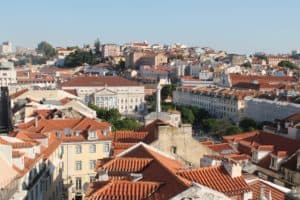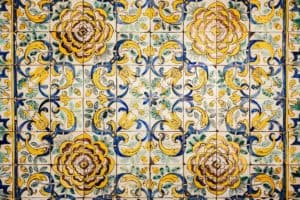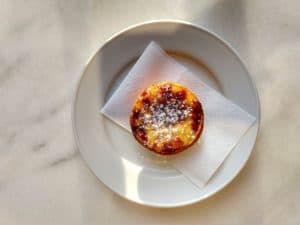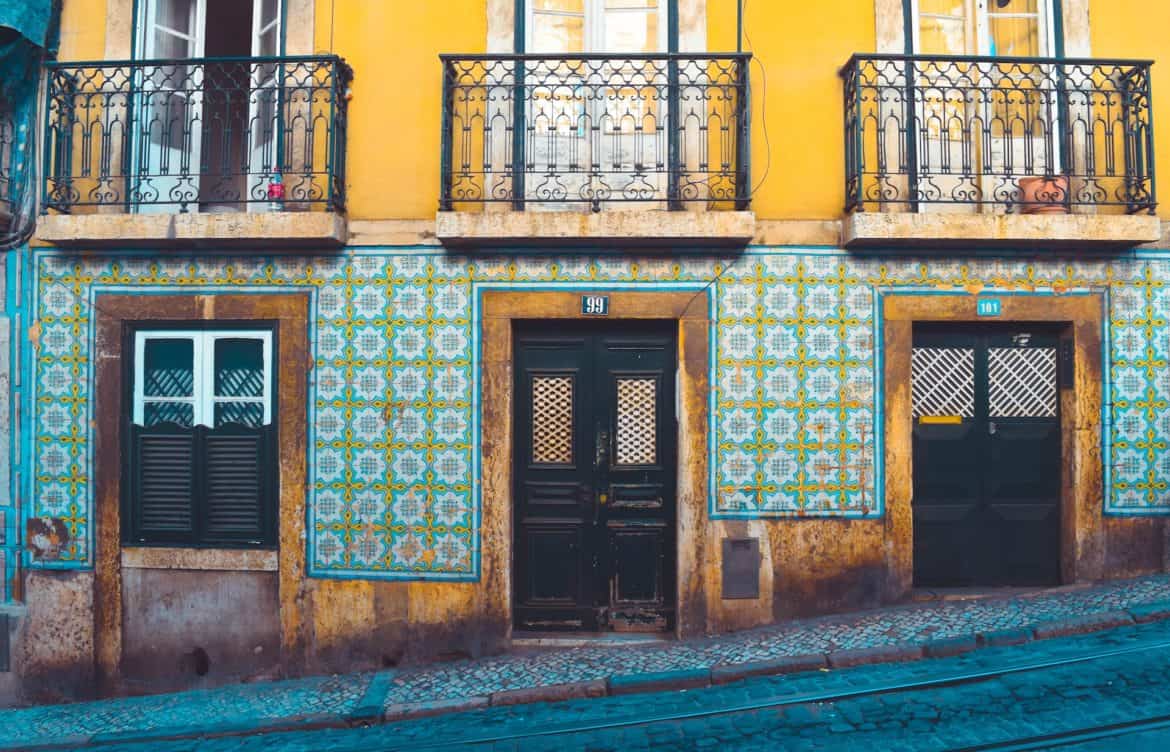Lisbon, the enchanting capital of Portugal, attracts visitors with its rich cultural heritage and breathtaking landscapes—as well as its legendary cuisine. At the core of this captivating city lies the Mouraria District, an area brimming with history, diversity, and delectable Portuguese fare. Our Lisbon Walking Food Tour offers tourists a truly immersive journey that combines exploration of Mouraria’s storied past with an indulgent escapade into Lisbon’s renowned culinary delights. Along the way, you’ll witness the mesmerizing cityscape and encounter the warm Portuguese hospitality.
In this blog post, we will better understand why the Mouraria District is such a famous and beloved area of Portugal among tourists. It is an unmissable destination to explore with our guides while you sample iconic Portuguese dishes and gain a deeper understanding of their preparation methods and their significance to the country. Oh, and at the end of this blog post, we’ll also tell you a bit more about three of the dishes featured in our walking food tour: Pastel de Nata, Bifana, and Portuguese cheeses!
But remember, this is just a taste of what’s to come if you decide to join us on a Portuguese tour, as nothing can replace the experience of strolling through the streets of Mouraria alongside an experienced guide!
Soul of Lisbon: The Mouraria District
Nestled beneath the protective shadow of the medieval Castelo de São Jorge lies the Mouraria District, a symbol of Lisbon’s diverse history. Known as the ‘Moorish quarter,’ Mouraria’s narrative can be traced back to the 8th century when Moors established a fortified city there, an event that also provided the district with its name.
The Moors, a Muslim population from North Africa, lived harmoniously in Mouraria for centuries, even after the Christian recapture of Lisbon in 1147. Many preferred to stay, live, and work under Christian rule, cohabitating peacefully with their Christian neighbors.
This mix of cultures thrived over centuries, crafting the unique personality of Mouraria. It’s seen through the narrow streets, quaint homes with beautifully tiled façades, small shops, and taverns — all whispering tales of a cosmopolitan community that prospered through religious and cultural dichotomies.
Today, Mouraria is a mosaic of tradition and progressive city life. While its streets and tight-knit houses reflect its historical roots, Mouraria’s present is characterized by the multicultural communities, artists, and bustling gastronomic scene infusing vibrancy into its old soul.

Over the course of its revitalization, Mouraria has become a vibrant hub of contemporary Lisbon, teeming with life and color. Walls are adorned with urban art, making it a living gallery of street art celebrating its cultural diversity. Traditional taverns and modern eateries co-exist, offering a gastronomic journey that combines classic Portuguese cuisine with the flavors introduced by recent immigrant communities.
A Birthplace of Fado
The historical significance of Mouraria doesn’t end with its Moorish roots. Musical history resonates from Mouraria’s heart, as it nurtured Fado – a traditional Portuguese music genre synonymous with love, loss, and longing.
Rooted in the 1820s, Fado emerged from the passionate voices of the district’s dwellers, embodying the spirit of Portuguese ‘saudade’ — a unique expression of intense longing, an acute sense of loneliness. The soulful melodies often narrated tales of the sea or the life of the poor and were typically performed by soloists known as ‘fadistas’ accompanied by the classical Portuguese guitar.
Notably, it was in Mouraria that the first Fado song was performed by a woman named Maria Severa. Today, her life and work are celebrated as a testament to Fado’s heritage and perpetuated through modern renditions by gifted performers, thus etching Fado’s significance deeper into the cultural soul of Portugal.
Architecture

The district’s architecture is a visual timeline — capturing the eclectic blend of centuries-old buildings with modern, stylish constructions. Its maze-like streets are flanked with tightly-knit houses adorned with colorful tiled facades, a signature architectural characteristic of Portugal known as ‘azulejo’. These houses speak volumes of the district’s past that saw the synthesis of Moorish and Christian influences in its architectural landscape.
Additionally, Mouraria is home to several historical landmarks such as the gothic-style Church of St. Mary Magdalene and the modern Mouraria’s Music Valley — a symbol of the district’s recent urban revitalization project.
Diverse Culinary Delights of Mouraria
Mouraria’s culinary landscape embodies the soul of Portugal’s food heritage. Here’s a deep dive into the history and cultural significance of a few of the bites featured on our Secret Food Tour Lisbon:
Portuguese Cheeses
Cheese making in Portugal dates back several centuries and is deeply rooted in the country’s agricultural traditions. Each region of Portugal produces its unique cheese, boasting distinct flavors and textures. Cheese production was predominantly a household chore across rural Portugal, making it an integral part of daily life and family traditions.
Our Lisbon walking food tour unwraps the richness of Portuguese cheese culture, offering an extensive tasting of renowned and artisanal cheeses, each carrying a unique story of its origin. Sampling these regional cheeses does more than satiate your gastronomic curiosity – it gives you a taste of Portugal’s rural lifestyle, family traditions, and regional differences.
Since we’re here, if you’re crazy about cheese, don’t miss checking out our blog post “Top 5 French Cheese“!
Pastel de Nata

Pastel de Nata, a traditional egg custard tart and Portugal’s most famous sweet treat, carries a significant historical and cultural background. Originating in the 18th century in a Lisbon monastery named Jerónimos Monastery, these custard treats were baked by the monks using leftover egg yolks from starching clothes. The pastéis de nata gained popularity among the locals and soon took off as a full-fledged business when the monks sold the recipe to a sugar refinery, which opened the iconic bakery Fábrica de Pastéis de Belém.
Pastel de Nata preparation involves creating a delicately flaky crust filled with a creamy, slightly caramelized custard center. The crust dough is thinly rolled and shaped into rounds, and then spoonfuls of custard mixture is gently placed in each. Baked until the tops become speckled with dark spots, they are often dusted with cinnamon and powdered sugar.
On our Lisbon walking food tour, you will get a chance to experience the city’s best Pastel de Nata, learning how the methods employed by bakeries have been perfected over the years.
Bifana
The Bifana, a traditional pork sandwich, holds an esteemed place in Portuguese culture, originally coming from the region of Alentejo. Its humble story begins with local butchers and chefs who sought to create an inexpensive, flavorful meal using readily available ingredients. Over the years, the Bifana has become more than just a street-side snack—it’s a symbol of Portuguese identity and simplicity.
Making a Bifana starts with marinating thin pork cutlets in a blend of white wine, garlic, and traditional Portuguese spices. The marinated pork is then grilled or fried and arranged in soft bread rolls. The sandwich is typically served with a dash of spicy piri-piri sauce or mustard.
Our food tour guide will take you to a very authentic place in Mouraria where Bifanas are prepared following the traditional methods, allowing for a genuine taste of this timeless Portuguese classic.
Mouraria’s Food Journey Beyond Tasting
Our Lisbon walking food tour offers an unrivaled gastronomical experience, deeply embedding the cultural importance of each dish. As you embark on the tour and delve into Mouraria’s historical alleys, our expert guides share fascinating stories associated with the locale and the food sampled, making every bite a journey through Portugal’s rich heritage.
Conclusion: A Timeless, Unforgettable Journey Through Mouraria

The Mouraria district promises to capture your heart with its rich history and shockingly good culinary wonders waiting to be explored. Our Lisbon Walking Food Tour is an experience unparalleled in its authentic fusion of culture and gastronomy. You’ll uncover the tales behind Mouraria’s ancient walls, feast on the delicious treats that represent Portugal’s multifaceted culinary traditions, and witness how the past and present blend seamlessly to tell the powerful story of a city that has withstood the test of time.
As you walk the same streets trodden by centuries of Lisbon’s inhabitants, you’ll come to understand the essence of this incredible city, leaving with a treasure trove of cherished experiences and cherished memories permanently etched into your heart. So why wait to answer the alluring call of Lisbon’s past, its tastes, and the dynamic heartbeat of its lifesblood? Embrace the adventure that awaits, and join us in our Lisbon Walking Food Tour, the beginning of your love affair with the captivating Mouraria District.
Want to know a bit more about the gastronomic surprises Lisbon holds? Don’t miss the opportunity to check out our blog post “Tradition, Tradition, Tradition” about one of the oldest restaurants in Lisbon!
But if you’re looking to learn more about the locations where our tours take place and want to delve into historical districts, make sure to check out our blog post about Malá Strana District In Prague!
